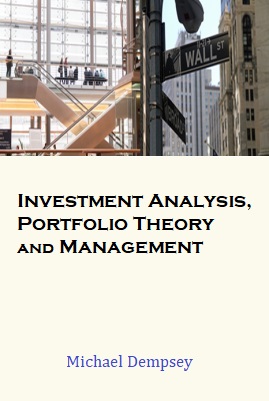
Forthcoming

Forthcoming
Forthcoming….

332pp. Dec 2015
ISBN: 978-1-78326-699-9 (hardcover)
ISBN: 978-1-78326-701-9 (ebook)
Sample Chapters:
Chapter 1: Introduction: Stock Markets, Investments and Corporate Financial Decision Making
Chapter 7: The Statistical Growth of Asset Portfolios
Reviews:
“I enjoyed reading the book. It has a light-hearted style that makes it easy to read and appreciate the underlying concepts.” – Professor Raghavendra Rau, Sir Evelyn de Rothschild Professor of Finance, University of Cambridge, UK.
“Michael Dempsey takes a new look at some well-travelled trails in finance ranging from asset pricing through corporate finance to ethics. He provides interesting and challenging insights and in some cases a view completely contrary to the accepted wisdom. He does this with a rigour, clarity and brevity that makes his work an easy read for both the expert and the student. His occasionally resort to humour might be seen as a lack of serious intent by some, but this is a serious and scholarly work. Scholarly does not have to mean boring and this book is certainly not boring. It is full of ideas worth reading because they stimulate thought and they challenge much of the established orthodoxy. I recommend this book to anyone seriously interested in finance.” – Professor Graham Partington, The University of Sydney Business School, Australia.
“The text has a refreshing and easy-to-read style that makes it easy to grasp the concepts as they build to a unified framework of markets and investment responses. The text reads with plausibility throughout, and it is only on reflection that one realizes that the author has advanced a range of “break-through” concepts, most notably, perhaps, the insight that patterns of observed price formation which we seek to attribute to “investor behaviour” may simply be due to inevitable mathematical patterns that follow from outcomes that approximate to a normal distribution. The text is iconoclastic. It seeks to debunk a good deal of modern finance theory, from the CAPM and Modigliani and Miller to the Fama and French three-factor model, to Markowitz theory, as well as established contributions from John Cochrane and Paul Samuelson. But the writing is always stimulating. Definitely a “must read” for PhD students in finance.” – Professor Malick Sy, Investment Adviser, Singapore.
“I found the book entertaining, easy to read and that it offers a different perspective to issues compared with other texts.” – Dr Philip Gharghori, Department of Banking and Finance, Monash University, Australia.
“The book represents a fully-accomplished and long awaited text in finance. The reader of Professor Michael Dempsey’s book will encounter the basics of finance and the directions of advanced finance. I recommend this book not only to students of finance but also to the businessman who seeks familiarity with the world off finance.” – Professor Hiroshi Osano, Institute of Economic Research, Kyoto University, Japan.
“The text is designed perfectly for the ambitious PhD student in Finance seeking to understand the current status of the subject matter and the potential of research in finance to add to a meaningful understanding of markets.” – Dr Abdullah Alawadi, The Public Authority for Applied Education and Training (CPAAET), Kuwait.
“The text first takes a critical look at the foundations of modern finance and finds deficiencies in the standard models. It then proceeds to show how understanding the mechanics of growth leads to alternative models with much more intuitive outcomes. The author should be congratulated for the key insights he provides, and the text should be regarded as essential reading for those seeking to understand financial markets.” – Dr Graham Bornholt, Department of Accounting, Finance and Economics, Griffith Business School, Gold Coast, Australia.
ISBN: 978-1-78634-325-3 (hardcover)
ISBN: 978-1-78634-326-0 (softcover)
Sample Chapters:
Introduction
The text examines the nature of the stock market and its implications for corporate management. As such, the text provides an introduction to core issues in finance. The text differs from traditional textbooks in its recognition that “finance is not physics” – in the sense that how markets behave today is not necessarily how they will behave tomorrow. In case we are tempted to think otherwise, the text commences with a history of markets that highlights the unpredictability of stock market events as: crashes in share valuations, speculative euphoria for dot.com stocks, and bank crises. Nevertheless, a certain level of “physics” can be recognized as underpinning the development of stock market valuations and corporate financial decision-making. It is this physics that the present text seeks to convey. However, rather than subscribe unthinkingly to an “efficient market hypothesis”, at each stage of the development of the text’s conceptual framework of understanding, the text recognizes the reality of market “sentiment” and the “fundamental uncertainty” that managers face in their decisions. In short, the objective of the text is to instill “wisdom and insight” in regards to the functioning of markets and corporate behavior, as opposed to algebraic derivations from unrealistic assumptions.
The study documents how the financial pages at the time were reporting the health of the economy and financial markets in the periods leading up to, during, and in the aftermath of Black Monday of 19th October 1987. We witness how in this time the economy was impacted by inflation, interest rate responses by central banks, currency exchange rates, budget deficits and international trade, as well as stock market speculation. We also observe the political agreements/disagreements across nations as the US sought essentially expansionary (Keynesian) policies while Germany and Japan sought to adhere to more restrained non-inflationary (monetary policy) growth.
Download this Report:
Part 1 (7.4 mb)
Part 2 (10 mb)